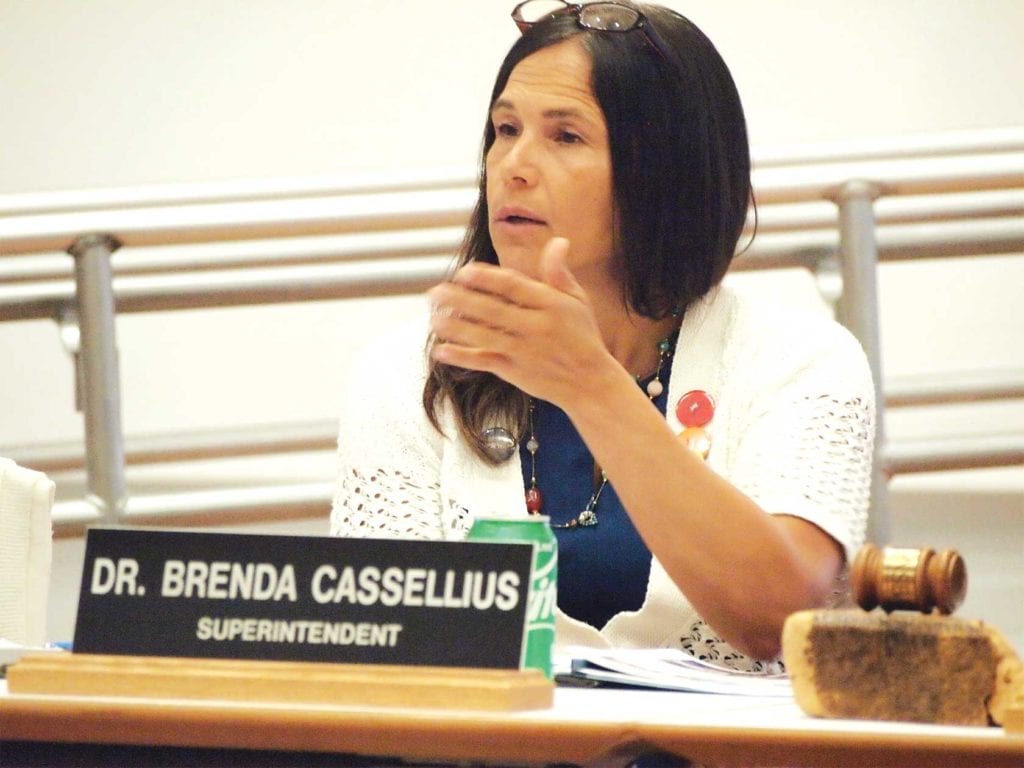
Boston Public Schools Superintendent Brenda Cassellius has undertaken an extensive community engagement tour aimed at helping to update the district’s priorities.
In a meeting with reporters and during a special meeting of the Boston School Committee last Wednesday, Cassellius, who started in the superintendent role on July 1, spoke about the district’s goals and took questions on a wide range of education-related issues.
The School Committee meeting was centered on the school department’s five-point strategic action plan, a 2014 document that calls for improved student outcomes, improved school quality, strong district leadership, effective resource allocation and greater community involvement with schools.
“It’s still very relevant today,” Cassellius said of the strategic action plan during the school committee meeting. “But like any other documents in an organization, it needs updating.”
Cassellius walked School Committee members through a slide presentation on the plan, noting that the district had made progress in some areas, but not in others.
“What you’re seeing generally is that we’re pretty stable,” she said, noting that the district has gone through two superintendents since the plan was rolled out. “To stay stable with that much turnover is a testament to the system.”
Measures on most academic areas remained stable, with an improvement in the four-year graduation rate, but a decline in the percentage of students enrolled in college within 16 months of high school graduation. The achievement gap between special education students and regular education students narrowed, while the same gap widened slightly for English language learners.
School Committee member Michael O’Neill noted that Cassellius’ presentation was the first update the body has been given on the plan.
“This is the first time since we approved this plan that we’ve actually seen this,” he said.
Others members raised a variety of concerns about the district. Alexandra Oliver-Dávila noted that while Latino students make up 44 percent of the district’s student body, Latino parents are underrepresented in parent councils.
School Committee member Lorna Rivera questioned the efficacy of the current student assignment system, which places students in schools based mainly on their neighborhood proximity. Noting that the city is largely segregated by race and income, Rivera, a Roslindale resident, said that her own son spent three years in a school that had no playground.
“The neighborhood where you live is what really determines what school you go to,” she said. “That’s a functional inequality in the way we handle school assignment.”
Q and A
In her meeting with reporters, Cassellius answered a range of questions. On the city’s BuildBPS plan to build new schools and renovate existing ones, she said that the transition of traditional elementary, middle and high schools to a K-6, 7-12 model may need a better-developed timeline, but she remains committed to following through with the plan.
“Most people have said they’re OK with the current plan to go K-6 and 7-12,” she said. “I haven’t had a lot of feedback on that structure. They’re just more interested in knowing what it is so that they can depend on and plan on it.”
Earlier in the summer, Cassellius suggested the district may look at an alternative to the controversial ISEE test for entrance to the city’s three exam schools, citing the cost of the test. On Wednesday, when asked whether she’s still thinking about changes to the admissions process for exam schools, Cassellius indicated she is no longer considering changes.
“I don’t have any further thoughts on that at this time,” she said.
Cassellius also said she plans to look at the district’s practices with inclusion students — students with disabilities who are educated alongside regular-education students. While many inclusion classrooms have one teacher certified in regular education and special education, teachers have been pushing for the addition of a second teacher licensed in special education to be added to such classrooms.
Cassellius said she is working with the Boston Teachers Union to discuss the best approach to teaching in inclusion classrooms.
“I don’t want to come with preconceived notions, because I want to look at what the best practices are for staffing, for setting, and for the curriculum and services that are needed,” she said.
The superintendent said the school district’s departments that manage special education and English language learners report directly to her.
“I did that purposefully because of the attention that I think is needed in these two areas specifically in order to improve the outcomes for children,” she said.
She also said she is learning the governance models of parent engagement groups, such as the Citywide Parent Council.
“There are many different governance models,” she said. “There are parent councils that really function as parent councils, there are governing boards in autonomous schools, there’s the School Committee, there are groups like CEAC [the Community Engagement Advisory Council], the SpedPAC [Special Education Parent Advisory Council] — there’s a number of groups, and I’d like to bring some coherence to that.”
Also in the meeting with reporters, Cassellius said she has so far held 26 meetings, including dozens with community-based organizations and education advocates in recent weeks. This week she is beginning a 100-day tour of the district’s 125 schools.
“My intention is to come in and quickly assess the school culture and climate,” she told School Committee members.
The engagement tour also will include town hall meetings and meetings with teachers, parent councils and bus drivers.






